Hydrophobic interactions - Study guides, Class notes & Summaries
Looking for the best study guides, study notes and summaries about Hydrophobic interactions? On this page you'll find 1560 study documents about Hydrophobic interactions.
Page 4 out of 1.560 results
Sort by
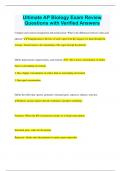
-
Ultimate AP Biology Exam Review Questions with Verified Answers
- Exam (elaborations) • 23 pages • 2024
- Available in package deal
-
- $9.99
- + learn more
Ultimate AP Biology Exam Review Questions with Verified Answers Compare and contrast transpiration and translocation. What is the difference between xylem and phloem? Tranpspiration is the loss of water vapor from the surgace of a plant through the stomata. Translocation is the channeling of the sugar through the phloem. Define hypoosmotic, hyperosmotic, and isomotic 1. Has a lower concentration of solutes than its surrounding enviorment 2. Has a higher concentration of solutes than i...
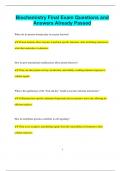
-
Biochemistry Final Exam Questions and Answers Already Passed
- Exam (elaborations) • 23 pages • 2024
-
- $9.99
- + learn more
Biochemistry Final Exam Questions and Answers Already Passed What role do protein domains play in enzyme function? Protein domains allow enzymes to perform specific functions, often facilitating interactions with other molecules or substrates. How do post-translational modifications affect protein behavior? They can alter protein activity, localization, and stability, enabling dynamic responses to cellular signals. What is the significance of the "lock and key" model in e...
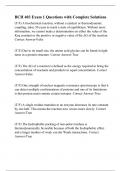
-
BCH 403 Exam 1 Questions with Complete Solutions
- Exam (elaborations) • 12 pages • 2024
-
- $15.49
- + learn more
(T/F) A biochemical reaction, without a catalyst or thermodynamic coupling, takes 50 years to reach a state of equilibrium. Without more information, we cannot make a determination on either the value of the Keq constant or the positive or negative value of the ΔG of the reaction. Correct Answer-False (T/F) Due to its small size, the amino acid glycine can be found in tight turns in a protein structure. Correct Answer-True (T/F) The ΔG of a reaction is defined as the energy required to b...
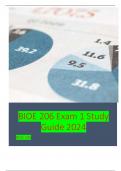
-
BIOE 206 Exam 1 Study Guide 2024
- Exam (elaborations) • 14 pages • 2024
-
- $13.99
- + learn more
How does information flow? From DNA to RNA to protein What information is central to modern biotechnology? The use of methods to study and manipulate information about the central dogma. What is the exception to the central dogma? The transcription of RNA into DNA using reverse transcriptase. How does the cycle of the central dogma work? Instructions of DNA are transcribed onto messenger RNA. The ribosomes are able to read the genetic information inscribed on a strange of the ...
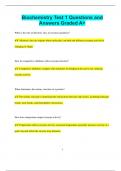
-
Biochemistry Test 1 Questions and Answers Graded A+
- Exam (elaborations) • 33 pages • 2024
-
- $10.49
- + learn more
Biochemistry Test 1 Questions and Answers Graded A+ What is the role of allosteric sites in enzyme regulation? Allosteric sites are regions where molecules can bind and influence enzyme activity by changing its shape. How do competitive inhibitors affect enzyme function? Competitive inhibitors compete with substrates for binding at the active site, reducing enzyme activity. What determines the tertiary structure of a protein? The tertiary structure is determined by interactio...
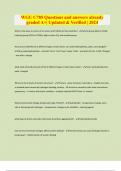
-
WGU C785 Questions and answers already graded A+| Updated & Verified | 2024
- Exam (elaborations) • 30 pages • 2024
- Available in package deal
-
- $13.29
- + learn more
What is the basic structure of an amino acid? What do they look like? - amino group (NH2 or NH3), carboxyl group (COO or COOH), alpha carbon (C), and variable group How do you identify the 3 different types of side chains: non-polar/hydrophobic, polar, and charged? - Non-polar/hydrophobic - end with CH or "can't have" water. Polar - end with OH, SH, or NH. Charged - end with a charge what kinds of bonds do each of the 3 different types of side chains make? - ionic, hydrophobic/non- pola...
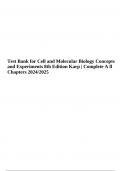
-
Test Bank for Cell and Molecular Biology Concepts and Experiments 8th Edition Karp | Complete A ll Chapters 2024/2025 | VERIFIED
- Exam (elaborations) • 122 pages • 2024
-
- $35.49
- + learn more
Test Bank for Cell and Molecular Biology Concepts and Experiments 8th Edition Karp | Complete A ll Chapters 2024/2025 | VERIFIED. Which of the following groups is capable of only hydrophilic interactions? d. H H C C C H H H H e.. H a.. OH b. C C C C C H H SH H H H H H H H H CH C C H H H H H NH 2 c.. C CH3 CH2 OH 2 C C C H H H NH H H OH 2 e. C C C C C H H H H H H H H H H H a. d. OH C C C H H H H H SH C O CH c. 3 OH b. C O Page 2 a) A b) B c) C d) D ...

-
BMSC 200 - Module 2 || Already Passed.
- Exam (elaborations) • 8 pages • 2024
- Available in package deal
-
- $10.79
- + learn more
Electronegativity of water correct answers The different electronegativities of hydrogen and oxygen make water a polar molecule capable of forming hydrogen bonds. This makes water a good solute. Hydrophobic interactions correct answers Non-polar hydrophobic compounds dissolve poorly in water. These compounds minimize their surface area exposed to water by forming aggregates in which the hydrophobic groups go to the interior through hydrophobic interactions. Only the more polar portions intera...
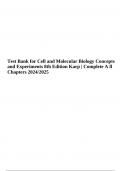
-
Test Bank for Cell and Molecular Biology Concepts and Experiments 8th Edition Karp | Complete A ll Chapters 2024/2025
- Exam (elaborations) • 122 pages • 2024
-
- $34.49
- + learn more
Test Bank for Cell and Molecular Biology Concepts and Experiments 8th Edition Karp - Complete A ll Chapters 2024/2025. Which of the following tripeptides would be most likely to be soluble in an organic (hydrophobic) solvent like benzene? a) N - phenylalanine - alanine - glycine – C b) N - leucine - alanine - lysine - C c) N - proline - phenylalanine - leucine - C d) N - arginine - lysine - proline - C e) N - glutamate - aspartate - glycine – C Answer: c Difficulty: Hard Learning Ob...
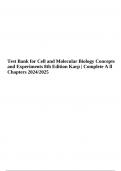
-
Test Bank for Cell and Molecular Biology Concepts and Experiments 8th Edition Karp | Complete A ll Chapters 2024/2025
- Exam (elaborations) • 122 pages • 2024
-
- $32.49
- + learn more
Test Bank for Cell and Molecular Biology Concepts and Experiments 8th Edition Karp | Complete A ll Chapters 2024/2025. Which of the groups below is capable of only hydrophobic interactions? a) A b) B c) C d) D e) E Answer: e Difficulty: Medium Learning Objective: LO 2.3 Describe the role of noncovalent bonds in the structure of molecules such as water. Section Reference: Section 2.3 Noncovalent Bonds 2) Which of the following groups is capable of only hydrophilic interactions? d. H...

How much did you already spend on Stuvia? Imagine there are plenty more of you out there paying for study notes, but this time YOU are the seller. Ka-ching! Discover all about earning on Stuvia


